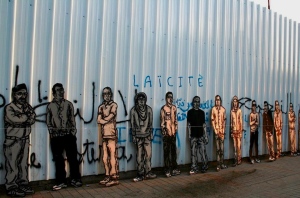Public Art, Public Statements: An Opinion on Graffiti
by Elyssa Jechow
Graffiti is a dirty word. Right? Or so it might seem to many of us in our perception of this Italian word that originally meant to scratch designs on walls. The word has been used in English at least since the nineteenth century, before the advent of spray paint, and that fact reminds us that graffiti is not just an activity of delinquent teenage boys. Think about it: every survey course in Art History teaches about the Lascaux cave paintings.
Humans have been scratching on walls for at least 32,000 years.
There was a purpose behind those paintings. Ancient humans modified their surroundings in order to record everyday life. These guys created a legacy that has lived on throughout history, and that continues today. I have seen for myself in the excavations of Pompeii — the one example of graffiti mentioned in the definition of the word by the Oxford English Dictionary! — and Roman citizens created plenty of art painted on walls and carved in public places. Yet even in those ancient times already there was a tension between commissioned art beautifying buildings and images left behind by so-named vandals.
Those vandals bring up another point. Graffiti is oft used not just to record, but also to make a statement. There is some unfortunate vandalism, to be sure. Yet there is also what we call street art, public art, guerrilla art. Street art is technically definable, usually referring to unsanctioned art that is produced in public spaces, but since that definition does not really speak to medium, genre, or materials, then we realize that street art is boundless in its possible range.
Artists resisting more traditional forms often engage in street art. Strong movements of the form emerge in newly liberated places, such as when that infamous wall fell. In that vein, we know that historically speaking, creative movements explode in places with newfound freedom – what better way to make your social or political message public, than well, in public. Recently, the world haswatched in awe as the Arab Spring has taken hold in northern Africa and the Middle East. Right along with the emergence of newly vocal masses, has been the emergence of street artists using their skill to make visual statements.

Zoo Project (Photo: http://www.zooproject.com)
Google “street art Tunisia” and you immediately find that a street artist who goes by ZOO Project has posed hundreds of painted life size statues all over Tunis representing “the brave ordinary people who risked their lives to stand up for their rights and revolt against tyranny.” Do a search of “street art Egypt” and you come across a striking image of Hosni Mubarak with “Leave Mubarak” painted expertly around it on the outside of a building.
Street art in these places, as in so many others, has helped some to find an integral voice. Art created in public spaces is alive and well not only in far-removed places, but also close to home – and in some very diverse forms. Many street artists have moved on from scrawling with paint to sculpture to other media for installations, even yarn.

Kachmar’s Mr. Rogers, and his sweater (Photo: http://www.aliciakachmar.com)
Famously, the Lower East Side artist Olek crocheted the Wall Street bull into a snazzy coat of pink and purple. Even here in Pittsburgh, crafter Alicia Kachmar was commissioned (What’s that? This stuff is commissioned now!) to crochet a sweater for the statue of Mr. Rogers on the North Shore.
Other works, like Bob Ziller’s “Flowers,” are simply meant to beautify the city we live in. According to PopCity Magazine, the project started when Ziller painted some flowers on boarded up windows, and is now funded by the Sprout Fund (click here for that article). He often works with AmeriCorps and other youth volunteers to “bring a glimmer of hope to more than fifty buildings from Wilkinsburg to Braddock.” Countless other examples of public art can be found all over Pittsburgh.
It’s clear to me that street artists are more than vandals – whether they’ve been record-keepers, beautifiers, or even revolutionaries – artists throughout history have thought outside of, hmm, outside the canvas. We’re quick to condemn someone who uses a public space for art that might not be oh-so-traditional, but can we challenge ourselves just a bit? Can we take a step back and think this is maybe more than what we think at first glance? Most of the time, this is more than an act of vandalism – it’s a statement, it’s our history. Like so many other pieces of art, it is something that we can look back on and remember use as a tool to tell us about who we were so many years before.

Olek, Installations (Photo: http://agataolek.com/home.html)
Links:
http://www.popcitymedia.com/features/streetart072011.aspx
For related articles from The Muse Dialogue:
Vol. 1, No. 4 Street Art and Public Art Table of Contents












Trackbacks & Pingbacks